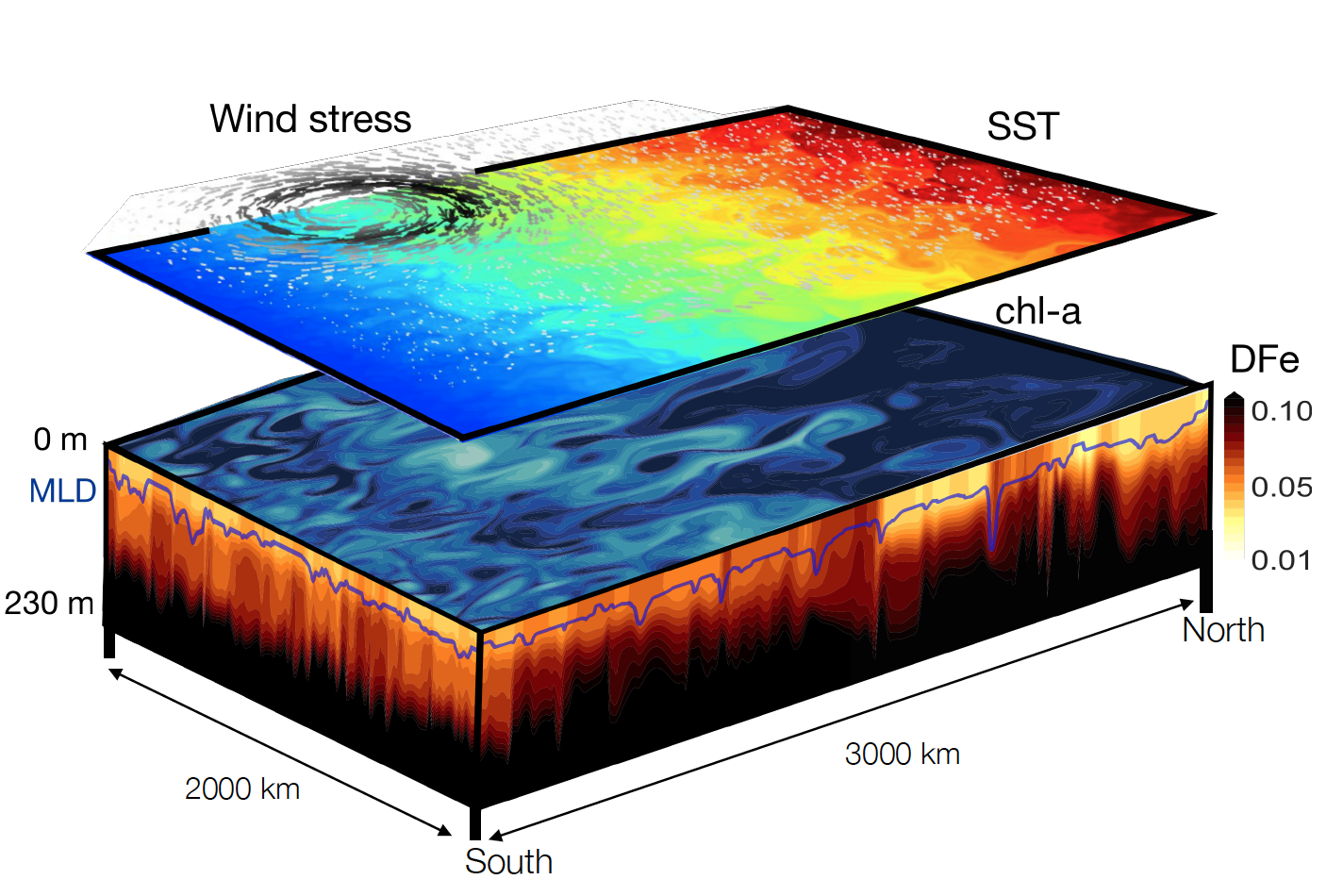WP4 : Quantification of the sources of uncertainty due to scale interactions.
Task 4.1 Impact of model resolution on tracer transport at basin scale
PIs: M. Lévy, X. Capet
The purpose of this task is to quantify how the scales that are not resolved in eORCA025 may affect tracer transport in the Southern Ocean. This is done through: 1) review of existing literature; 2) an idealized model configuration at high-resolution; 3) LES modeling
Task 4.1.1
Two review papers have been submitted, one on the role of small-scales on marine productivity (Lévy et al., 2018), the other on export production (Boyd et al., 2018).
Task 4.1.2
Set-up of an idealized model configuration to study to role of processes in the scale range R 1/24°<R<1/4°.
The open ocean conditions of the Southern Ocean are represented with a periodic reentry channel (Figure 1). In this configuration, the flow of the ACC is unobstructed by landmass allowing it to circumnavigate and reconnect back on itself. The configuration was initialized using a hierarchical approach of increasing horizontal resolution (dx), starting from dx = 1°, which was initialized from rest and adjusted for 200 years. This was used to initialize a run at dx = 1/6° which, initialized the dx = 1/24°. Our analysis will be based on the dx = 1/24° run, referred here on as B24S, which is mesoscale resolving and sub-mesoscale permitting run with seasonal and intraseasonal (storms) forcing.

Figure 1: Three-dimensional representation of the model setup. Top panel:Sea-surface Temperature (SST) overlaid with a snapshot of wind stress vectors in gray. Below is a model snapshot of surface chlorophyll. On the sides are sections of upper ocean dissolved Iron (DFe), with the purple line denoting the mixed-layer depth.
This model configuration is being used to evaluate the role of small-scale processes, combined with storms: A) on primary production, B) export and C) anthropogenic carbon penetration.
A) Primary production (S. Nicholson)
The experiments have been performed and analyzed. One publication is in preparation (Nicholson et al. in preparation)
B) Export (L. Resplandy + S. Nicholson + post-doc)
One paper has been submitted on the method (Resplandy et al., 2018)
The application of this method to Southern Ocean conditions will start in 2019 (post-doc)
C) Anthropogenic carbon (Thesis N. Aldea-Ramos)
The study is based on synthetic tracer experiments intended to mimic anthropogenic carbon penetration, which are included in the above model configuration. The high-simulation experiment has been performed, and the subduction rate of the tracer evaluated online. Subsequently, we will focus on how the subduction rate is affected by data resolution, and we will perform offline diagnostics based on the same fields projected onto coarser resolution model grids.
Task 4.1.3
The impact of resolution on small-scale vertical fluxes of nutrients was assessed with a model of even higher resolution (resolving submesoscales and some turbulent scales) using an LES model in a frontal zone configuration of 2 km x 2km horizontal size, i.e. nearly the size of one pixel in the previous configuration. One paper has been submitted (Whitt et al., 2018)
Task 4.2 Study of chaotic eddy-driven variability of Southern Ocean biogeochemistry!
PIs : M. Gehlen, T. Penduff,
The purpose of this task is to quantify how chaotic eddy-driven, low frequency variability of physical variables affect Southern Ocean biogeochemistry. This study has been carried out on the basis of an ensemble of three ¼° global simulations . Using the metrics developed by OCCIPUT project, the focus here is on primary production and air sea CO2 fluxes The outcome is the first quantification of the magnitude of chaotic eddy-driven low frequency variability of Southern Ocean biogeochemistry. A manuscript describing this study is in preparation (Gehlen et al.)